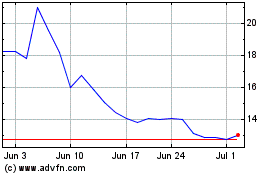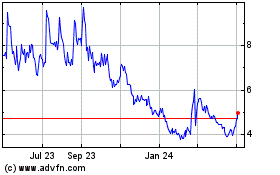By Taylor Umlauf and Peter Loftus
Seven coronavirus vaccines are rolling out across six continents
to slow the global pandemic, and more are in late-stage testing.
The shots use different technologies to help people mount the
molecular defenses that can fend off Covid-19.
Vaccines from Moderna Inc. and Pfizer Inc. and its German
partner BioNTech SE mobilize immune defenses using genetic
molecules known as messenger RNA packaged in fat envelopes, while
AstraZeneca Inc.'s vaccine and Russia's Sputnik V shot deliver
immune prompts with the help of common, harmless viruses. A
Beijing-based drug-development unit of China National
Pharmaceutical Group Co., known more commonly as Sinopharm, relies
on the traditional vaccine approach: prompting immune defenses
against a dangerous virus by injecting a defanged version of the
pathogen. Another vaccine, now in late-stage testing from
U.S.-based Novavax Inc., relies on a fourth technology.
The vaccines appeared to have different levels of effectiveness
during testing, and different side effect risks. The following
explains how each of these vaccines works.
Genetic-Code
The mRNA technology behind the Pfizer and Moderna vaccines --
the two currently in use in the U.S. -- had never been approved
before the pandemic. Messenger RNA carries to cells the genetic
instructions for making proteins. The mRNA vaccines ferry orders,
engineered in a lab, for making a harmless version of the protein
from the novel coronavirus, prompting cells to make the protein and
the immune system to mobilize molecular defenses that can spring
into action if exposed to the real coronavirus.
Among the Covid-19 vaccines currently in use, mRNA vaccines have
had the highest efficacy rates during late-stage testing.
Moderna
-- Available in: U.S., Canada, parts of Europe, Israel
-- Doses: 2
-- Efficacy: 94%
-- Most common side effects: Injection-site pain, fatigue,
headache, muscle pain
Pfizer
-- Available in: U.S., Canada, Mexico, U.K., parts of Europe and
the Middle East, Ecuador and Singapore
-- Doses: 2
-- Efficacy: 95%
-- Most common side effects: Injection-site pain, fatigue,
headache, muscle pain
Virus-Based
Two of China's vaccines rely on the traditional vaccine method,
much like the technology behind shots for the flu or polio. These
traditional vaccines use a killed or weakened form of the targeted
virus to generate an immune response that can protect against the
pathogen. So far, studies on the effectiveness of Covid-19 vaccines
using the traditional technology have shown them to have lower
efficacy rates than other shots with late-stage study results.
China's state-owned Sinopharm
-- Available in: China, Bahrain, Serbia, U.A.E., Seychelles
-- Doses: 2
-- Efficacy: 79%, interim Phase 3 results
-- Most common side effects: Injection-site pain, headache,
muscle pain, fever
Sinovac Biotech Ltd.
-- Available in: China, Brazil, Indonesia, Turkey
-- Doses: 2
-- Efficacy: 50% (based on clinical trials in Brazil)
-- Most common side effects: Unknown
Viral Vectors
Several vaccines use what is known as a viral-vector approach, a
reference to how the shots deliver immune-mobilization orders. The
technology is behind some relatively new vaccines to protect
against another deadly infectious disease, Ebola.
Among the viral-vector Covid-19 vaccines are AstraZeneca's,
developed with the University of Oxford and in use in the U.K. and
across Europe; Russia's Sputnik V; a vaccine from China's CanSino
Biologics Inc., working with the Chinese military. The shots use a
modified virus -- like the virus responsible for common colds -- to
carry genetic instructions teaching cells to make a protein from
the coronavirus.
A fourth viral-vector vaccine, from Johnson & Johnson, is in
late-stage testing and could be authorized for use in the U.S. as
early as February.
AstraZeneca
-- Available in: U.K.
-- Doses: 2
-- Efficacy: 62% (with two doses)
-- Most common side effects: Unknown
Johnson & Johnson
-- Not yet approved for distribution
-- Doses: 1 or 2, pending outcome of clinical trials
-- Efficacy: 66% (based on results released from a large
clinical trial Friday), with 72% in the U.S., 66% in Latin America
and 57% in South Africa
-- Most common side effects: Fatigue, headache, muscle pain,
injection-site pain
Sputnik V
-- Available in: Russia, Serbia, Argentina
-- Doses: 2 (Russia is also offering to foreign customers who
want to speed up vaccinations a one-dose version, Sputnik Light,
consisting of the first dose of the regular Sputnik vaccine.)
-- Efficacy: 91.4%, in an interim analysis
-- Most common side effects: Injection-site pain and flu-like
symptoms including fever, weakness, fatigue and headache
CanSino Biologics, working with the Chinese military
-- Available in: China
-- Doses: 1
-- Efficacy: Unknown
-- Most common side effects: Unknown
Protein-Based
Researchers designed these vaccines to generate an immune
response to the coronavirus by introducing one of its proteins,
like the spike protein jutting from its surface. The presence of
the protein, or something resembling it, should provoke the immune
system to develop defenses against the virus, the researchers say.
Covid-19 vaccines based on the technology aren't available yet.
Novavax's shot, which is in late-stage testing, could be rolled out
in the U.S. in spring or summer if it proves to work safely.
Novavax
-- Not yet approved for distribution
-- Doses: 2
-- Efficacy: 89% effective (based on results released from a
late-stage study in the U.K. Thursday), with 49% in South Africa
(based on a mid-stage trial)
-- Most common side effects: Injection-site pain, fatigue,
headache, muscle ache
Sources: Our World In Data (for distribution locations); World
Health Organization (doses)
Write to Peter Loftus at peter.loftus@wsj.com
(END) Dow Jones Newswires
January 29, 2021 17:39 ET (22:39 GMT)
Copyright (c) 2021 Dow Jones & Company, Inc.
Novavax (NASDAQ:NVAX)
Historical Stock Chart
From Mar 2024 to Apr 2024

Novavax (NASDAQ:NVAX)
Historical Stock Chart
From Apr 2023 to Apr 2024
